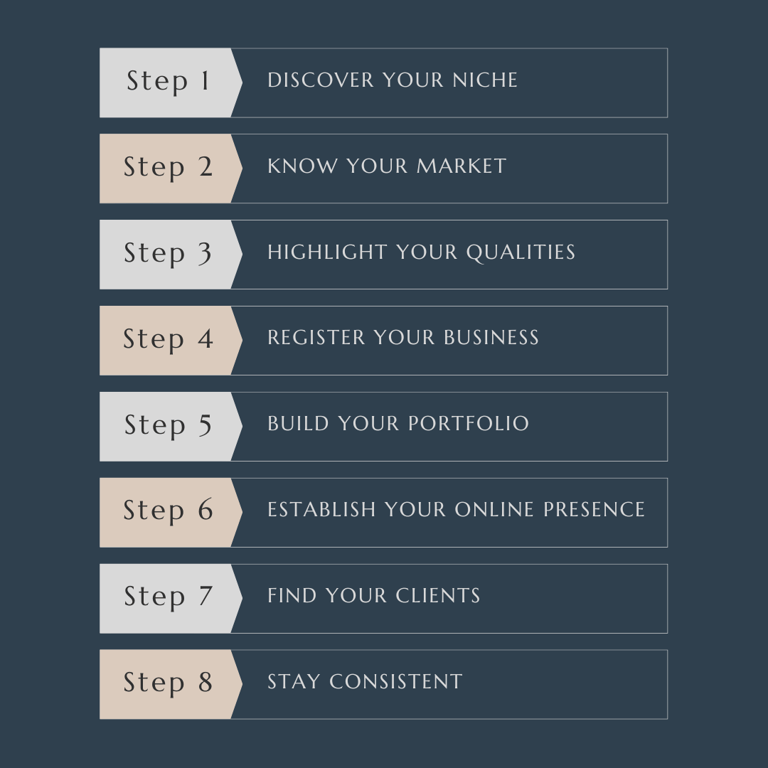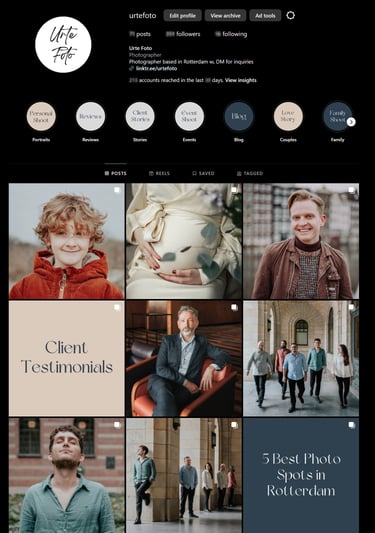How to Start a Photography Business in the Netherlands
Urte Foto
3/8/202411 min read


Have you ever thought about taking your passion for photography to the next level? Maybe you're thinking about turning your hobby into a business. I've been there myself! I understand the uncertainty that comes with taking the first steps, especially when you don't know where to start. That's why I've written this article - to share my personal journey of turning photography into a full-time career. I hope that my experiences will provide you with valuable insights, or at the very least inspire you to embark on your own journey towards realising your creative dreams.
When I started my photography business in the Netherlands, I didn't spend much time researching the industry or writing a detailed business plan. I just took action and started making and sharing images.
So, my advice? Just start! Regardless of whether you've spent a lot of hours planning and crafting a business strategy or immersed yourself in market research, the most important step is to start where you are. Like many, I didn't have any previous business or marketing experience, nor did I have any industry connections to consult. Instead, I learned everything along the way, one step at a time.
In this article, I'll take you through eight important steps to get your photography business started in the Netherlands. But before we dive in, don't forget to subscribe to my newsletter at the bottom of this page for future tips, insights and exclusive offers to help you on your photography journey.
Picture by Urte Foto




1. Discover your identity as a photographer
Starting a photography business often begins with defining your creative identity. It may seem overwhelming to narrow your focus at first, but identifying a niche can provide clarity and direction. Here are some of the most common photography niches in which you could position yourself:
Family & children photography
Newborn photography
Wedding photography
Fashion photography
Event photography
Product photography
Architecture/Interior Photography
Sports Photography
Animal photography
etc...
When I started my business in the Netherlands, I faced the same dilemma. Based on my passion for photographing families and children, I positioned myself as a family photographer. This strategic decision not only demonstrated my expertise, but also gave me the confidence to deliver excellent results.
It's natural to resist being confined to a single label or category. However, I soon realised the power of highlighting my core strengths from the outset. By embracing these strengths and passions, you convey authenticity and competence to potential clients, laying the groundwork for effective business development.
Take a moment to reflect: What resonates most with you? What aspect of photography sparks your enthusiasm and aligns with your vision? Whether it's capturing intimate family moments or staging elegant wedding scenes, trust your instincts and choose a niche to embark on your journey. Remember, your chosen niche isn't set in stone; it's a starting point that can evolve and expand as you grow your business and develop a loyal clientele.


Pictures by Urte Foto
2. Understand your market and your positioning
I admit that I didn't do a lot of market research when I started out as a photographer in the Netherlands. I relied more on intuition and trial and error to navigate my way through. In hindsight, however, I would advise spending some time understanding the landscape of your industry and where you fit into it.
Take a moment to observe what other professionals in your field are doing and how they are doing it. This step is important, especially in the early stages, as it will help answer key questions such as how much to charge, what services to offer and how to deliver them. Trust me, you don't want to find yourself overworking and undercharging without realising it.
So put some effort into researching the market. This can be as simple as Googling photographers in your niche and examining their online presence. Take note of the variations you see, especially in terms of quality and pricing. Experienced photographers with polished websites and curated portfolios will often charge more than those just starting out with a basic Instagram page.
Once you've gathered insights from your research, assess your own experience, confidence and values. This introspection will help you determine what you can offer and what you should charge for it.
If you're still unsure about pricing, don't hesitate to experiment. Take on a few initial assignments and if you feel you've undervalued yourself, use this experience to adjust your pricing for future projects accordingly. Remember, your time and effort have value, and it's important to recognise and reflect that. By finding your sweet spot, you'll not only establish your value, but also build confidence in your pricing strategy.


Picture by Firmbee | Downloaded from Pexels
3. What makes you stand out? Make it shine!
As you explore the landscape of your niche market, take note of the unique qualities and strengths that set you apart from other photographers. Embrace these distinctive attributes and showcase them prominently in your portfolio and online presence. Whether it's your meticulous attention to colour grading, your innovative fusion of digital and analogue techniques, or your innate ability to create a warm and relaxed atmosphere that encourages natural, candid moments - these are the elements that define your signature style.
In a creative field where it's easy to feel overshadowed by the abundance of talent, remember this: the market may seem saturated, but there's always room for those who dare to stand out. If I had let the sceptics discourage me with their talk of saturation in the photography market, I would never have realised the joy of creative freedom and the fulfilment of turning my passion into a thriving business.
In the realm of creative endeavour, perseverance and consistency are the keys to success. By honing your unique skills, effectively marketing your strengths and continually refining your craft, you can carve out your own niche in the competitive landscape of photography. Remember, it's not just about being good at what you do - it's about being confident in your talents and letting your creativity shine.


Pictures by Urte Foto
4. Register your business with the Dutch Chamber of Commerce (KVK)
Before you start working with clients, it's important to formalise your business by registering with the Dutch Chamber of Commerce (Kamer van Koophandel or KVK). This straightforward process lays the foundations for your business and provides you with legal protection as a business owner.
Start by visiting the official KVK website to familiarise yourself with the registration process and explore the various legal structures available, such as sole proprietorship, partnership and others. Each structure has its advantages and implications, so it's important to understand which option best suits your business objectives and circumstances.
Taking the time to consult with an advisor or accountant can provide valuable insight into tax obligations and financial planning. Understanding your tax responsibilities, including VAT and income tax, is essential to ensuring compliance and avoiding penalties. For example, as a sole proprietorship, you may be required to pay quarterly VAT and annual income tax, as well as health insurance contributions.
NOTE: While I'm sharing my experiences here, it's important to note that I'm not giving legal advice. The information presented is based on my personal journey and it's the reader's responsibility to verify official information, especially when dealing with law and legal matters. Seeking professional advice can ensure compliance and financial stability as you embark on your photography business journey.


Picture by Urte Foto
5. Build your portfolio with TFP shoots
Building your portfolio with TFP (Time for Print) based photo shoots is a good idea when starting out as a photographer. If you don't have the photographic material to showcase your skills, don't worry, there are ways to get it without spending a fortune. One approach is to work with models who are willing to pose for you in exchange for high-quality images.
Since budget constraints may limit your ability to hire professional models, consider reaching out to friends and family or joining local Facebook groups for photographers, models and makeup artists (MUAs). These groups are a great resource for finding potential collaborators. When posting in these groups, introduce yourself and explain that you're building your portfolio and looking for models for TFP shoots. Be sure to include specific details about the type of shoot you have in mind, using examples from platforms like Pinterest to illustrate your vision.
Now, you may not be familiar with the term "TFP". It stands for "Time for Print" or "Time for Pics". Essentially, it's an agreement where the photographer retains exclusive rights to use the images for both commercial and non-commercial purposes, while the model receives high quality images free of charge. To protect your rights and ensure clarity in the relationship, it's advisable to draft a model release agreement for each TFP shoot. This document outlines the terms of the agreement, protects your ability to share and use the images in the future, and provides peace of mind for both parties.




Pictures by Urte Foto
6. Build your online presence
Now that you've identified your niche, researched the competition and gained insight into current trends and pricing strategies, it's time to establish your online presence. While investing in a fancy website might seem like the logical next step, starting with an Instagram account can be just as effective, if not more so, in getting your business off the ground.
Here's a tip that will set you apart from the crowd: plan your Instagram feed meticulously. This doesn't just mean deciding what content to post, but also ensuring a cohesive and professional look and feel. At the end of each month, I create a mockup of my Instagram feed, arranging sample images to visualise how it will look in the coming month. This careful planning ensures that my feed accurately represents my photography style and maintains a polished aesthetic. Tools like Photoshop, InDesign or Canva can help you organise your Instagram grid effectively.
Once you've mapped out your content, determine the frequency of your posts. I typically aim to post three times a week, usually in the evenings, to align with my audience's activity times. Using Instagram analytics can provide valuable insights into when your followers are most active, allowing you to optimise your posting schedule.
To streamline the posting process, consider using Facebook Business Manager to schedule your Instagram posts for the coming month. This efficient approach only requires one day of your time, but frees you up to focus on other aspects of your business in the coming months, while maintaining a consistent and engaging social media presence.


7. Find Your Clients - Put Yourself Out There
Now that you've built up your portfolio, it's time to start attracting new clients. If you're just starting out and haven't made a name for yourself in the local photography scene, your first assignments may come with low fees or even be free of charge. This approach minimises risk for both parties and gives you the freedom to experiment creatively while providing a valuable service. To protect your time investment, it's important to have clients sign model release agreements, as discussed in point 5.
But how do you find your first clients? One effective strategy is to use online platforms such as Facebook groups. Join relevant groups, introduce yourself and offer discounted or free photo shoots to kick-start your portfolio. While this approach is beneficial in the beginning, avoid becoming dependent on it. As you gain experience and confidence, gradually increase your prices to reflect the value of your work.
In addition to networking online, don't hesitate to reach out to local businesses that may be in need of photography services. Offer to meet for a chat and suggest a free mini-shoot to demonstrate your skills. Building relationships and establishing rapport with potential clients is key. Attend local networking events, hand out business cards and confidently showcase your work. Remember, it's not just about the end product; it's also about your ability to connect with people, understand their needs and offer solutions.
Don't underestimate the power of referrals and reviews. Encourage satisfied clients to leave reviews that you can showcase on your portfolio and social media channels. Express your openness to future collaboration and referrals, nurturing your existing network and growing it organically.
By refining your approach to finding clients and emphasising the importance of networking, you'll gradually build a solid client base and establish yourself as a reputable photographer in the Netherlands.


Picture by Urte Foto
8. Consistency is key
On the journey of building your photography business, there will inevitably be moments of doubt, setbacks and challenges. It's easy to feel discouraged when faced with stagnant growth, a lack of clients or financial difficulties. But it's during these tough times that your resilience and determination will be put to the test.
Push forward: Instead of giving in to the temptation to give up on your dreams, it's important to push forward with determination. True success often lies on the other side of adversity, and only those who persevere through the toughest times will ultimately emerge as victors.
Self-reflection: When you face obstacles, take a moment to critically evaluate your strategies and approach. Are you consistently promoting yourself and your work? Have you undervalued your services by not adjusting your prices accordingly? Are you feeling uninspired, resulting in repetitive and dull work? Identifying the root causes of your challenges is the first step to overcoming them.
Seek support: Remember, you don't have to do it alone. Reach out to friends, fellow photographers or marketing professionals for advice and support. Consider investing in a session with a business advisor or mentor who can provide valuable insights tailored to your niche. There's always room for improvement and growth, and seeking guidance from those with experience can help you overcome obstacles more effectively.
Believe in yourself: Ultimately, success in the photography business requires a combination of perseverance, self-awareness and belief in your abilities. While external factors may influence your journey, it's your resilience and determination that will ultimately determine your success. Embrace challenges as opportunities for growth and trust in your ability to navigate through uncertainty to a brighter future.


Picture by Urte Foto
Final thoughts
While there's much more to explore about starting and maintaining a photography business, such as investing time in training to hone your photography and communication skills, continually refining your brand's visual identity and online presence, staying up to date with industry trends, and regularly evaluating and adjusting your business strategies, I want to emphasise one crucial point: just get started.
Don't be held back by the fear of imperfection. Start with what you have, even if it's not perfect. Take that first step, pick up your camera and start capturing moments. Share your work with the world, whether through social media or your website. As you immerse yourself in the journey of running a photography business, you'll gradually gain clarity about your niche, refine your skills and develop your unique style.
Remember, trust your abilities and embrace the process of growth and discovery. Every photograph you take and every experience you have will contribute to your development as a photographer and entrepreneur. So trust yourself, stay resilient and keep moving forward on your path to success.
I hope this article has inspired you to take the next steps in your photography journey. If you're ready to turn your passion into a thriving business and are looking for images that represent you as a professional, I'm here to help. Don't hesitate to get in touch if you have any questions or would like to work with me.
Until next time,
Disclaimer: All the images featured in this article are the exclusive property of Urte Foto and are protected by copyright law. Only Urte Foto has obtained explicit permission from the individuals depicted in the images for their use on Urte Foto's website and social media channels. If you wish to use any visual content from the Urte Foto website, you must first obtain written permission from the photographer.
